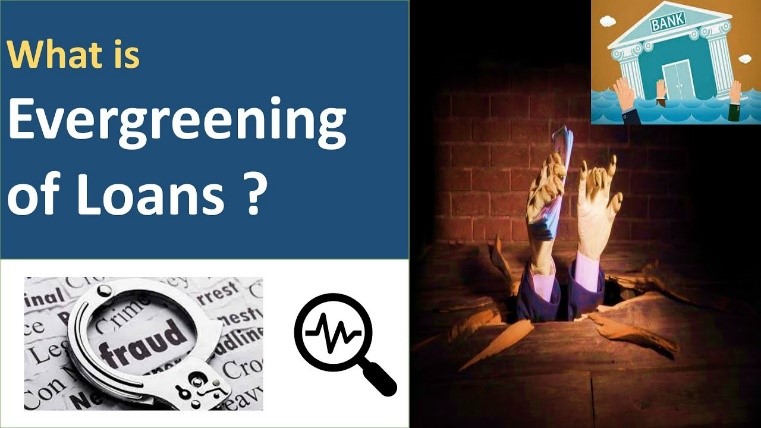Description

Disclaimer: Copyright infringement not intended.
Context
- RBI Governor Shaktikanta Das raised red flags over banks adopting innovative methods for the evergreening of loans.
What is evergreening?
- Evergreening of loans is a practice where banks revive a loan by a borrower who is on the verge of default by granting more loans to the same borrower.
- In other words, evergreening refers to giving a fresh loan to a borrower to pay up an old loan.
- It is a practice that is done to save the previous loan from defaulting so that it does not appear as a non-performing asset (NPA) on a bank’s books.
Why do some banks help borrowers engage in this practice?
- By hiding the actual stress on their books, banks can show a healthier balance sheet to investors and depositors to attract more business and investments.
- Also, banks need to provision — set aside money — for bad loans. Such provisions impact the profitability of banks.
.jpeg)
Description
- The process of evergreening of loans, a form of zombie lending, is typically a temporary fix for a bank.
- If an account turns into a non-performing asset (NPA), banks are required to make higher provisions which will impact their profitability.
- A loan turns into a nonperforming asset, or NPA, if the interest or instalment remains unpaid even after the due date — and remains unpaid for a period of more than 90 days.
- So, to avoid classifying a loan as an NPA, banks adopt the evergreening of loans. In the past, many banks had indulged in dressing up bad loans and given additional funds to companies who didn’t have the capacity to repay.
- Banks delay the recognition of losses due to loan defaults and engage in evergreening, which is essentially the rolling over of debts of unviable borrowers that would have otherwise defaulted. This is purely misgovernance so bad loans are made to look good many a time by additional lending to troubled borrowers.
- Evergreening normally happens due to the unholy relationship between bankers and borrowers.
Prevalence of the practice
- Some banks have even extended such loans to wilful defaulters to keep them out of the defaulters’ books.
- When the then RBI Governor Raghuram Rajan ordered an asset quality review in 2014, a host of concealed bad loans or NPAs surfaced. Poor project appraisal management by banks, especially public sector banks, and some shady promoters who were known for fund diversion, joined hands to evergreen loans.
- Industry experts highlighted that the practice was rampant between 2013 and 2015 but the apex bank’s asset quality review (AQR), initiated under then governor Raghuram Rajan in 2015, forced banks to disclose all hidden bad loans on their books.
- The RBI has taken an extremely cautious approach since then.
Economic Implications of Evergreening of Loans
- Ever-greening of loans has unfortunately been a widespread practice adopted by banks in the past to ever-green their stressed accounts (and avoid classification of NPAs which would require higher provisioning, compliances and impact profitability). This has led to huge debts getting piled up with borrower entities who clearly have no capacity to repay such loans, and ultimately results in a situation of hundreds (and in many cases thousands of crores) of bank debt remaining unpaid, a consequence much against the public interest at large.
- Time and again, the RBI has asked banks to refrain from the practice of evergreening loans because by doing so, banks hide the actual stress on their books. Eventually, such stressed loans evolve into a crisis.
Are there specific guidelines from the RBI on this subject?
- RBI in a master circular in April 2023, said that if banks are found to be evergreening loans and indulging in similar activities, they will be subject to stringent supervisory and enforcement actions.
RBI’S STATEMENT:
Under our supervisory, any action by lenders with an intent to conceal the actual status of accounts or evergreen the stressed accounts will be subjected to stringent supervisory or enforcement actions, including, but not limited to, higher provisioning on such accounts and monetary penalties,” said a statement from the central bank.
How can evergreening be stopped?
PJ Nayak Committee Recommendations
Wherever significant evergreening in a bank was detected by RBI, RBI should impose penalties wherein:
- Unvested stock options granted to officers who have indulged in the practice, and to all whole-time directors, be canceled in part or in full.
- Monetary bonuses paid to such officers and to all whole-time directors, be clawed back by the bank, in part or in full; and
- The chairman of the audit committee be asked to step down from the board of the bank.
Learning from the 2008 Financial Crisis
- It is unlikely that a bank could have low NPAs when many of its large borrowers are in distress. And it is likely that the low NPA levels are engineered by ever-greening.
- Between 2011 and 2014, India had high credit growth and low NPAs even when the underlying economic growth was slow. It appears that most of the high credit growth was driven by ever-greening. Thus, certain measures flag such cases in advance.
- Measures: The most important variables that matter include (i) interest coverage ratio; (ii) medium-term profitability; (iii) quality of auditors; (iv) volume of related party transactions; and (v) credit ratings of the borrowers.
Policy Measures
- First, Banks should be asked to report changes in key financial variables of their large borrowers. This will enable investors and depositors to take action before it is too late. An adverse stock price reaction could act as a credible deterrent. In the absence of this information, unfortunately, markets fail to do the surveillance job.
Borrower-Bank Fundamental Relationship
- Second, using a supervised machine learning program, it is possible to estimate the actual relationship between borrower fundamentals and bank fundamentals. The regulator should regularly calculate the expected NPA from the algorithm and ask the banks to explain significant deviations. If this measure is implemented, the regulators need not resort to draconian measures such as the AQR (asset quality review). This stress test information need not be made public.
- It is also important to invest more efforts in designing early warning measures of ever-greening. In a paper titled “Identifying Zombie Lending: Evidence Using Loan Level Data”, it has been shown that a loan that is renewed quickly just before the due date by the same officers who lent the initial loan is likely to be an ever-greened loan. If given data and resources, researchers can design better methods.
Other
- The primary defence against evergreening must however come from the CEO, the audit committee and the board.
- The audit committee, in particular, needs to be particularly vigilant. If significant evergreening is detected by RBI supervisors, it must mean that evergreening is willful, with support from sections of the senior management of the bank.
- It then becomes necessary to levy penalties and action against the erring officers.
|
PRACTICE QUESTION
Q. What do you understand by the term ‘Ever-Greening of Loans’? What are its Economic implications? How can evergreening be stopped? Suggest appropriate measures.
|

https://economictimes.indiatimes.com/industry/banking/finance/auditors-dilemma-when-is-evergreening-a-fraud/articleshow/69718411.cms?from=mdr













